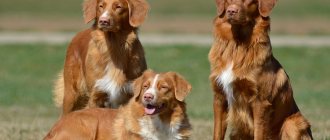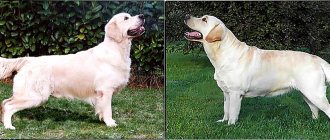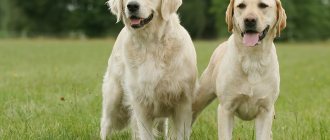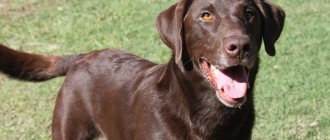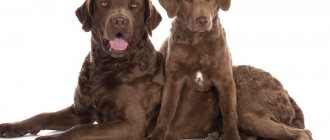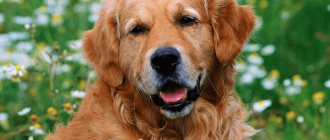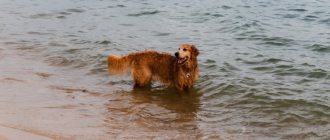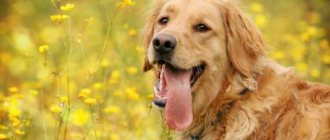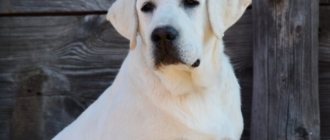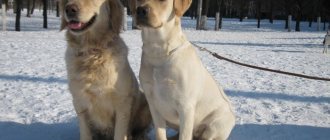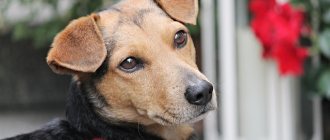The Flat-Coated Retriever (Flat Coated Retriever) is a breed of gundog that is primarily used for retrieving game from the water and on land. Flats are smart, friendly, mischievous and sociable; they become strongly attached to their owners, making them excellent companions and family dogs for active people.
Black flat
The Flat-Coated Retriever (Flat) is a hunting dog. His pedigree is a mix of Labrador, spaniel and collie breeds. The Flat differs from its golden counterpart by its straight coat and black color. According to the International Canine Association, there is an approved standard and appearance that all breeders of this dog are guided by.
Dossier
Height of an adult: height of adult males at the withers - from 59 to 61 cm, females - from 57 to 59 cm. Weight: from 25 to 36 kg. Characteristic color: dark chocolate brown or black. Coat length: medium, straight with a characteristic silky sheen. Life expectancy: 10-14 years. Advantages of the breed: intelligent with high working qualities. An excellent companion dog. Difficulties of the breed: affectionate, sensitive, difficult to cope with separation or change of owner. Average price: 90-100 dollars. Classification: medium breed from the group of retrievers, spaniels and water dogs. Refers to hunting.
Theses
The breed was bred in the mid-19th century to solve specific hunting problems.
A distinctive feature of the breed is its color; dogs can be liver or black in color.
They perform well on the hunt and are valued by real hunters. But they are not very common as pets in the CIS countries.
Flats have a soft, good-natured, playful character.
They get along well with children, but they are quite large and can inadvertently knock a child down.
Like all hunting breeds, they are very energetic and tireless, long walks are necessary.
Purpose and hunting with a straight-coated retriever (flat)
The Flat-Coated Retriever is endowed with all the qualities and abilities of a gundog. Compared to Goldens or Labradors, he is faster, more maneuverable and resilient. As befits a retriever, he simply loves water and is a very professional swimmer and diver. Smart and attentive, he skillfully scares away a bird within a shot. In addition, his keen sense of smell and resourcefulness allow him to quickly find game on land and in water. Adapts quickly to changing circumstances and will work equally well with owner, trainer or guest.
The Flat-Coated Retriever is a tireless, passionate hunter, an unsurpassed fetcher and tracker who is always ready to work.
It is worth noting that in terms of hunting use, flats are more versatile than other retrievers. They easily learn to work by following the blood trail, try to be the first everywhere and always, but their main quality is complete solubility in the owner. Flat is multi-talented and can be an athlete or a service dog. The most suitable disciplines for obedience and agility: agility, obedience, flyball, dancing with dogs. In service dog breeding, the work of a search dog or a guide dog suits him.
Advantages and disadvantages
A versatile, intelligent working dog with many talents, stable, sociable, friendly to everyone at home. The straight-haired is considered the most active among other retrievers, agile, intelligent, with lightning-fast reactions.
These active, hard-working animals constantly need something to do. They are ready to hunt, search or play something constantly. The Flat-Coated Retriever remains a good-natured, gentle, cheerful dog until old age. They are usually very friendly, so using fletts as guards will not work.
According to reviews from owners of straight-coated retrievers, this breed has virtually no disadvantages. Character – easy to train, affectionate, loyal. The appearance is balanced - elegant and powerful at the same time. The only negative is that sometimes there are “too many” pets. A lively temperament constantly forces the dog to look for more and more new adventures.
Character
It's a pleasure to spend time with a flat dog. Like its close relative the Golden Retriever, it is good-natured, energetic and intelligent, and tries to please its owner.
At home he gets along well with children and is sociable with other pets. At the same time, he needs physical activity. If its energy does not find an outlet, it becomes destructive.
Important! For most representatives of the breed, being alone for a long time is unacceptable; dogs need constant communication with their owner.
If a retriever is involved in a hunt, it can raise birds to be shot and bring back prey from both land and water.
The animal can make independent decisions and assess the situation
Characteristics and description of the breed
The popularity of golden retrievers is increasing year by year. More than 70 thousand of these dogs are registered every year in American clubs alone. The love for these animals is caused by their character - they are kind, well-mannered and playful, so any family will simply be delighted with them.
Aggressiveness
Depending on what kind of dog a Golden Retriever sees next to him, he may behave differently. This breed reacts as follows:
- when near small dogs, retrievers try not to approach them first, since they are not interested in them;
- They are wary of larger dogs and first look closely before starting communication.
Activity
Golden Retrievers are very active dogs. They can spend the whole day on the move, practically without stopping. They can always find something to do that suits their rhythm, but most of all they love it when their owner devotes his time to them.
Training
No matter how smart a dog is, it still needs training. With golden retrievers, training will be much faster than with other breeds, as these pets pick up everything on the fly.
Shedding
Many owners of golden retrievers claim that these dogs can shed heavily only in the spring, when the warming winter “coat” becomes a burden.
In bitches, shedding directly depends on the cycle, so they should pay special attention
Need for care
The Golden Retriever is a breed of dog that is simply not capable of living in a kennel; it is more accustomed to an apartment environment. For this reason, before purchasing a puppy, you need to understand how much time you can devote to it. Caring for a retriever is quite simple, but before this, the pet needs to be trained to use the tray from childhood. Some procedures must be carried out regularly, once a month or a week.
Friendliness and attitude towards children
It’s not for nothing that Golden Retrievers are called babysitters, because they love to spend time next to small children. Not only are they friendly and affectionate with them, but they can also calm them down if they sense that the children are worried about something. Retrievers often offer to play to distract the kids.
Health
Despite the fact that the retriever has innate instincts and hunting abilities, nature has not endowed it with good health. They are genetically predisposed to various types of diseases:
- obesity (you cannot overfeed these dogs, as they can gain a lot of excess weight in a short period of time);
- oncology;
- hip dysplasia, in which the dog feels constant pain and may limp;
- cataracts and entropion;
- skin diseases;
- cardiovascular diseases.
Attitude towards loneliness
It is not a good idea to leave golden retrievers alone in an empty apartment or house for a long time, as they may get bored. This breed can tolerate a few hours without their owner, but being alone all day will be an impossible task for them.
Maintenance cost
The initial expenses will be the largest and will range from 5 to 10 thousand rubles. This price includes bowls, toys, vaccinations, food and other necessary items for your pet. In subsequent months, expenses will be about 2.5-3 thousand.
Intelligence
Golden Retrievers are intelligent and intelligent dogs, which is why they are so trainable. According to Stanley Coren, this breed ranks fourth in the list of the most developed dogs.
Noise
Despite their activity, golden retrievers are characterized by silence and patience. They don’t make a fuss over any little thing and don’t annoy you with causeless loud barking.
Content Features
The Flat-Coated Retriever adapts well to life in a house or apartment. It is possible to keep an enclosure, but it is not advisable due to the fact that the dog needs close contact with the owner. Left to its own devices, it can develop bad habits. Flats love space and freedom; the best option for them would be to live in a private house outside the city. But it is worth noting that some flat dogs feel great in big cities if the owner spends a lot of time with the dog in a walking area or near a pond.
The Black Flat-Coated Retriever is susceptible to heatstroke. Cold tolerance varies from person to person. Some dogs bathe in icy water, others refuse to walk at -10°C.
The Flat-Coated Retriever is very energetic and active. Imitating hunting behavior during games and walks will help him fully develop physically and psychologically. Walking around the house is not enough for Flat. He should have the opportunity to run freely, swimming and playing with other dogs is encouraged. The total duration of daily walking should be about 90 minutes.
Care
The Flat-Coated Retriever does not require complex grooming. Grooming boils down to brushing the coat 1-2 times a week, weekly cleaning of the ears and teeth, monthly bathing and trimming the nails as needed. In addition, it is advisable to dry your ears well after swimming or swimming in a pond. During combing, special attention should be paid to the decorative hair on the legs and tail, as well as under the arms, where it is most prone to the formation of tangles.
Nutrition
Flats eat relatively little and easily adapt to the proposed type of food. This can be natural food or ready-made dry food. The owner chooses the best option, taking into account that the diet must be complete and correspond to the age, physical activity and physiological state of the dog. It is very advisable to observe portion sizes and diet.
Owners should remember the risk of gastric volvulus in their Flat-Coated Retriever and take all measures to prevent the pathological condition.
Training
Flat retrievers are dogs that amaze with their intelligence and learning abilities. From the first time they understand what fetching is and are happy to deliver the fetch. These are natural participants in agility competitions - the game of flyball. They don't need double commands because the dogs understand the essence of the task the first time.
But, nevertheless, these are the most vulnerable and very sensitive creatures. To work with flats, you need to be patient and delicately, without being too harsh, point out the shortcomings. Otherwise, the dog may simply refuse to work.
The main thing is to find eye-to-eye contact, since this breed tends to seek the owner’s gaze. This is how the dog asserts that it has correctly understood the command. If you have established contact and have complete understanding with your pet, you can applaud loudly - you are on the right path to complete success.
But flats are not particularly disciplined. Dogs of this energetic breed do not tolerate monotony and repeated repetitions of the material covered. At some stage, the dog may simply lose interest in activities.
Flat retrievers are always hungry for something new, more interesting and unfamiliar. They simply love to learn quickly, and are always happy to demonstrate their skills, and at the highest level. In addition, they absolutely love praise.
Colors
The genetics of the colors of such a dog can vary from classic golden shades to cream and almost white. The coat color of dogs of this breed can take on different shades of the above colors, with the exception of ginger and red.
The color of such dogs is usually uniform throughout the body, but many representatives of the breed may have small spots on the chest. Genetics and the correct content of vitamins and fats in the diet are responsible for the color characteristics of dogs. The intensity of the color is influenced by rufus polygenes, and if the dog has an overly light shade, this indicates that the color was influenced by another gene - cch.
The Golden Retriever is often confused with the Golden Setter due to their similar colors, but they are two completely different dog breeds.
The black retriever and mixed breed of this breed are not recognized by the international standard; professional breeders and elite nurseries sell such puppies several times cheaper.
Labrador
This breed can be called traditional; in American culture it is even customary to have a Labrador for each newborn child. Dogs are loyal friends and good workers. For this purpose they were bred in Canada at the end of the 19th century.
There are 3 versions of the origin of the name. The first comes from the name of the black rock – labrodorite. The second is from the possible place of origin (Labrador Island). The third is from the Portuguese word “labrador”, which means worker.
The Labrador standard requires 56 cm of height at the withers and no more than 40 kg of weight. But animals love to eat, quickly gain weight and suffer from obesity. In addition, modern Labradors are divided into European and American types: the first is characterized by light shades of coat and an elegant, light body; for the second – golden dark colors and a weighted body. Previously, only black was considered the standard coat color; now wheat and brown are common.
Some of the kindest family dogs in the world . Labradors are always in the top 3 pets for children. They love people, are affectionate and active. The breed is used less and less for hunting, although Retrievers still have natural qualities. They cope well with training, quickly remember commands, are not stubborn, but require education.
Now the dogs either serve in the border guard, or help the disabled, or lie next to the owner on the carpet and play with the child. They can be safely called nanny animals. The average price for a puppy is 25,000-40,000 rubles.
Types by coat type
The standard describes exactly what a Labrador's coat should be - short, thick, water-repellent, with a slight greasy coating. Short hair - hair up to 5 cm long. Longer hair on the tail is allowed. Waviness and curliness are classified as defects. Only sometimes the “sin” of waviness is forgiven in very good representatives of the breed.
So, it makes no sense to talk about smooth-haired and long-haired varieties of Labradors. Of course, such puppies can appear in a litter, but will be discarded.
True Labradors are smooth-haired and short-haired.
Among the representatives of the group of retrievers, there are indeed breeds and varieties with long, curly, curly and smooth hair. And the Golden Retriever is often mistakenly called a long-haired Labrador.
Education and training
Raising a pet should be done by an experienced and patient person. Although the curly-haired retriever is distinguished by its impeccable intelligence and intelligence, it requires explanations from the owner of the appropriateness of performing certain actions. Curleys are highly valued by hunters for their endurance and sensitive sense of smell.
These dogs are not very suitable for apartment living, as they require a very large space for walking. They cannot be left alone, and when raising them (even by a professional), the owner must be present. Curly Retrievers can be trained to compete in any type of dog competition where they can fully express their energy.
With proper training at home, the dog will show calmness
It is believed that the Curly Retriever is jealous and does not like it when its owner shows attention to someone else. But even despite this, the dog feels good in a team of other animals.
But it is better to train alone with your pet.
Walking, physical activity, rules of safe behavior on the street
A flat cat that needs high physical activity should be walked 2–3 times a day for 1–3 hours. During a walk, a dog should be able to run across flat or rough terrain, overcome obstacles and barriers, and retrieve objects thrown by the owner.
In some situations, you cannot let an animal off a leash:
- when located near the roadway;
- when passing by children's playgrounds;
- if the female is in heat.
In cold, rainy weather, it is better to reduce the time spent outside
Nutrition
When purchasing golden retriever puppies, it is important to ask what their diet was like at the kennel or with the previous owner. Ideally, at least three months should pass from birth before entering a new family.
Golden retriever puppies
At this time, the dog eats its mother's milk. But if this is not the case, then we need a worthy alternative. If the breeder is competent and conscientious, he will give future owners instructions on food intake. As for the retriever himself, he is tolerant of any food. But this does not mean at all that you need to feed him anything. In order for the retriever's coat to always remain beautiful and shiny, he will need calcium and other trace elements.
If the owner chooses premium dry food, then the question of taking additional vitamins will not arise, since the necessary components are already included in the factory diet. But if we are talking about natural food, then additives will be required in the bowl.
At least a third of an adult dog’s diet consists of proteins - turkey, chicken and beef, as well as sea fish once a week and cottage cheese
At the same time, it is important to remove excess fat from meat products, and also skin from poultry.
This is how golden retrievers ask to eat
The remaining proportions are approximately equally divided between complex carbohydrates such as buckwheat and rice and fiber. Acceptable vegetables include carrots, beets, cabbage, pumpkin, turnips and greens. They are grated and either served raw or stewed.
By the way, this breed is tolerant to milk, but only up to 6 months - the period while teeth change. This product can be given in its pure form or cereals can be cooked with it. And to ease the pain when teething, special store-bought bones, or cartilage and sinews are suitable.
If the owner prefers dry dog food, then it should be remembered that the Golden Retriever dog is prone to allergies. Therefore, frankly cheap products will not only not be suitable, but will even harm the dog.
What to feed your pet
For your dog to always feel great, it is not enough to know how to care for a Flat-Coated Retriever; you will need to feed the animal correctly. The owner is given the choice of feeding dry food or natural products.
When deciding to feed your Flat-Coated Retriever dry food, keep in mind that it is advisable to buy “premium class” food. Their composition is properly balanced and contains the necessary vitamins and minerals. All you have to do is make sure that there is always clean water in your pet’s bowl.
Nutrition based on natural products will require careful selection of the menu. The diet of a Flat-Coated Retriever must include meat. It is advisable to feed dogs natural food with added vitamins. A natural diet includes dairy products, organ meats, vegetables, grains and fruits.
Important! Experts strongly advise against feeding dogs mixed foods: dry food and natural products, even alternating portions of food. It is recommended to feed either the first or the second.
When feeding Flat-Coated Retriever puppies with natural products, keep in mind that the diet of a growing dog is somewhat different.
- During the period of active growth, the young individual receives food rich in calories and calcium.
- In the first months of life, the puppy drinks a sufficient amount of milk.
- Porridge is cooked in milk and meat broth.
- Meat should be present in the diet every day: beef or veal, cut into small pieces.
- Be sure to include fish in the menu. It is permissible to alternate fish days with meat days. It is advisable to give sea fish. If you want to treat your pet to a river catch, be sure to boil it before putting it in the dog’s bowl, and carefully remove small bones.
Health and illness
Unlike its closest relative, the Labrador, the health characteristics of the Flat-Coated Retriever are depressing for breeders and breed lovers. With a stated life expectancy of 12-15 years, dogs die much earlier than this. It is a rare case when a retriever lives to be 12 years old; representatives of the breed leave for the rainbow at 8-10 years of age. This is all due to the tendency to cancer, from which every third long-haired (straight-haired) retriever dies.
Main types of cancer:
- Lymphosarcoma is a malignant tumor of the lymph nodes. Symptoms of the disease include lethargy and apathy, problems with swallowing, loss of appetite and weight. In some cases, a representative of the breed experiences tachycardia and swelling of the paws. To identify the disease, a blood and urine test is performed and a biopsy is taken.
- Hemangiosarcoma is a tumor that occurs on the walls of blood vessels. Affects the spleen, liver, and heart parts. The manifestation of external signs depends on the location of the tumor; when the abdominal organs are affected, the dog’s abdomen becomes swollen. The main symptoms are expressed in the form of shortness of breath, pallor of the mucous membranes, general lethargy and depressed state of the pet.
- Osteosarcoma is cancer of bone tissue. In the first stages it is practically impossible to diagnose.
- Mastocytoma is a skin tumor that appears in dogs over 8 years of age, but can affect the animal at an earlier age. Most often, the tumor occurs on the torso, less often on the head and neck. For diagnosis, cytological and histological studies are performed.
- Melanoma is skin cancer. Most often found on the mucous membranes of the oral cavity and conjunctiva. Diagnosis is carried out using cytological examination, histological examination and biopsy.
In addition to oncology, the black retriever, according to the description of hereditary diseases of the breed, is prone to:
- Epilepsy. Most modern representatives of the breed are born with this disease.
- Heart pathologies and problems with the thyroid gland.
- Cataracts and glaucoma.
- Hip dysplasia.
Attitude towards children and others
Judging by the description of the breed, the black retriever is similar in character to the Labrador, just as sociable and kind. Only the Labrador is more sedate than the reckless and overly emotional Flat-Coated Retriever. For him, a person is an object for the manifestation of unbridled love; representatives of the breed are ready to lick anyone from head to toe, hug anyone with both paws, smiling from the ear of a dog’s mouth, and tell how glad they are to meet you.
When communicating with strangers, straight-coated retrievers are capable of going too far; if a person is a dog lover, he will react good-naturedly to the dog’s emotionality. What is it like for someone who is afraid of dogs? Such a man is walking down the street, and a large, black dog with an open mouth and a hanging tongue rushes towards him. The retriever has only one thought - to urgently meet and kiss the passerby. The latter thinks where to run if there is no shelter nearby except numerous trees. It is unlikely that a person will like the owner’s explanations about the good nature of his dog, who is ready to show his love to everyone.
To avoid such situations, retrievers are kept on a leash within the city. There is one more thing - these are numerous cats walking along the city streets. A representative of the breed will definitely rush after them, will not maim or kill, the dog is counting on the game. But you can’t explain this to the cat; she will run away and take the retriever with her.
Representatives of the breed adore children. Who else but the baby can be licked, furiously wagging its tail, or have fun joint games. Families with a small child are not recommended to have a straight-coated retriever. The dog is too energetic; when he gets excited, he is capable of hurting the baby by knocking him to the floor or stepping on him.
How to choose a puppy
Future owners have a few rules to follow, following which they will receive a worthy dog:
- The breed standard allows only black or liver coat color. Having decided to buy a puppy on your own, through an advertisement or from someone else, you should prepare for the fact that they will slip you a “mixture of a bulldog with a rhinoceros and a little mammoth” instead of a purebred flat (the name of the breed among dog lovers).
- If a potential buyer is shown the parents of a puppy, smooth-haired and red or sandy in color, he is deceived, trying to sell another dog under the guise of a retriever.
- Little puppies are curious and active. Active, with sparkling eyes and soft, dense fur, they are eager to get to know a stranger, because friendliness is in the blood of representatives of the breed.
- If the baby is lethargic, with dull fur and cloudy eyes, you should refuse to buy such a puppy. Professional breeders will never sell a sick baby; it can only be purchased by hand or through an advertisement, as described above.
The Flat-Coated Retriever is a temperamental and very affectionate dog. It is suitable for hunters and active people.
Nicknames and names
Following the tenets of cyberlinguistics, the name of a pet has a direct impact on the owner of the animal, and not just on him. After all, the nickname sounds many times even throughout the day. The combination of sounds causes particles to vibrate at a certain wave frequency, forming a mood and a certain kind of association.
The characteristics of sound also include the color factor, since color also has a wave nature. The ratio of major-minor, dark-light is the tonality, and quiet-loud, dim-bright is an indicator of the strength of the sound and the intensity of the light flux.
The names have not only a musical nature, but also color characteristics. The sound O displays a white and light yellow glow, A – deep red, I – blue.
The euphony of names and nicknames is perceived subconsciously by humans, and consciously by animals. Therefore, names for dogs are chosen that are euphonious, short, reflecting the pet’s character traits and influencing the fate of those around them. The main thing is that the name is to the liking of its bearer.
Since the nickname is already included in the pedigree, it is advisable to know its origin, who it was worn by, as well as the fate of the one whose name the dog will bear
This is very important, since dogs tend to accept the inheritance of a tragic name
Photos and price of puppies
The price of one straight-haired retriever puppy is 50 thousand rubles.
Sources
- https://pets2.me/bok/618-chernyy-volosatyy-labrador-ohotnichya-poroda-sobak-pryamosherstnyy-retriver.html
- https://cesarsway.ru/poroda-sobak-pryamosherstnyiy-retriver.html
- https://catfishes.ru/pryamosherstnyj-retriver/
- https://usatiki.ru/pryamoshyorstnyj-retriver/
- https://vashipitomcy.ru/publ/sobaki/porody_sobak/prjamosherstnyj_retriver_vneshnij_vid_kharakter_ukhod_zdorove_foto/23-1-0-2434
- https://dogsta.ru/priamosherstnyi-retriver/
- https://www.PorodiCobak.ru/porody-sobak/pryamosherstnyj-retriver
- https://DogCentr.ru/porody-sobak/pryamosherstnyj-retriver.html
- https://www.moiasobaka.com/vse-o-porodah/srednie/pryamosherstnyj-retriver.html
Origin story
The Flat-Coated Retriever originates from Great Britain. Also known by its English name, flat-coated retriever, but more often it is simply called Flat. It is a direct descendant of the wavy-coated retriever, which in turn descended from St. John. By the middle of the 19th century, as a result of competent selection work, the flat, as intended, became an almost universal assistant for a hunter with excellent retrieval abilities and an elegant appearance.
Judging by the surviving data, many breeds took part in the breeding of straight-coated retrievers: Irish water spaniel, bloodhound, foxhound, Scottish collie, as well as bulldogs and terriers. A new breed was introduced in 1860 under the name wavy-coated retriever. The most prominent representatives were the dogs of the breeder R. Bryceford; it was they who became the ancestors of the first lines.
Further selection brought some changes to the breed, including a coat that became impermeable to water and lost its waviness. It was decided to change the name of the breed. In 1898, the dogs were first listed in the stud book of the English Kennel Club under the name Flat-coated retriever. Over the next few decades, the breed did not lose its position on the list of the most popular in the UK. In 1923, the Association of Fans of Flat-Coated Retrievers was created. In 1935 the breed was officially recognized by the FCI.
Purpose and hunting with a straight-coated retriever (flat)
The Flat-Coated Retriever is endowed with all the qualities and abilities of a gundog. Compared to Goldens or Labradors, he is faster, more maneuverable and resilient. As befits a retriever, he simply loves water, swims and dives very professionally. Smart and attentive, he skillfully flushes away a bird within a shot. In addition, his keen sense of smell and resourcefulness allow him to quickly find game on land and in water. Adapts quickly to changing circumstances and will work equally well with owner, trainer or guest.
The Flat-Coated Retriever is a tireless, passionate hunter, an unsurpassed fetcher and tracker who is always ready to work.
It is worth noting that in terms of hunting use, flats are more versatile than other retrievers. They easily learn to work by following the blood trail, try to be the first everywhere and always, but their main quality is complete solubility in the owner. Flat is multi-talented and can be an athlete or a service dog. The most suitable disciplines for obedience and agility: agility, obedience, flyball, dancing with dogs. In service dog breeding, the work of a search dog or a guide dog suits him.
Video about the dog breed Flat-Coated Retriever (Flat-Coated Retriever, Flat):
Brief historical background
Great Britain is considered the homeland of these animals. Work on their removal lasted about fifty years. Their ancestors include Labradors, setters and greyhounds. The first Flat-Coated Retriever was shown in 1860 at an exhibition held in Birmingham. The owner of this dog, named Widham, was Sir Braildesford, whose dogs became the ancestors of all existing lines.
In 1905, the breed received official recognition from world cynological organizations. These animals were brought to Russia relatively recently. But they have already gained some popularity among local breeders and hunters.
Where to buy a retriever
Since these dogs are not yet very popular in our area, it can be quite difficult to buy a straight-coated retriever. There are kennels for straight-coated retrievers, but there are few of them and they are located in large cities, so if you are not a resident of such a city, then it may well be that To get a puppy, you will have to go on a short trip around our vast homeland. You can also look for advertisements for the sale of Flat-Coated Retriever puppies on the Internet or on community sites dedicated to this breed of dog. Sometimes these dogs can be found at dog shows, so you can wander around and look for the dog of your dreams. The price of a Straight Coated Retriever puppy can be up to $800 if we are talking about a puppy purchased from a kennel, but if you buy a puppy from your own, it can cost a little less.
Flat-Coated Retriever: Description
The Flat-Coated Retriever is a fairly large male dog; at the withers it can reach a height of 60 centimeters. In appearance, these dogs are similar to a regular golden retriever, but their hair is slightly longer and the color is not golden, but black or brown. There should not be any spots of a different color on the dog. This breed standard for Flat-Coated Retrievers was adopted back in 1880 and has not changed since then. After the adoption of the standard, just a few years later the dog breed was recognized by the International Association of Dog Breeders and became an independent breed.
Retriever character
Like other retrievers, the straight-coated retriever has a very friendly character, they do not behave aggressively towards other animals or people, on the contrary, all people, even strangers, dogs of this breed are always very happy to see, therefore the straight-coated retriever is not suitable for the role of a guard to develop aggression A straight-haired retriever cannot interact with a person even with the help of special training. Flat-Coated Retrievers have no problems with children; they quickly find a common language and very often become true friends.
If you have other animals living at home, and you decide to get yourself another straight-haired retriever, then you can do it safely and you won’t have any problems. And even if you already have an adult retriever at home. If you decide to get another animal, for example, a kitten or a dog, then there will be no problems and in this case the retriever will easily find a common language with the new tenant. In the family, the straight-haired retriever tries to take the dominant place, although in the family he chooses one leader, whom he obeys unquestioningly and loves until he loses consciousness; the straight-haired retriever also loves the rest of the family members and treats everyone equally.
Keeping a Flat-Coated Retriever
A straight-haired retriever, a dog that cannot be kept outside, is an indoor dog, so if you live in a private house, make sure that your pet has either a room where he can hide from the frost in winter, or give the dog a corner in the house. If you decide to place your pet in a house, then the place where the dog will sleep should be well protected from drafts, and the dog should be able to see everything that is happening in the house or apartment; retrievers are very curious by nature and suffer greatly if something happens without them participation. Retrievers love walks in the fresh air, and they need them for the normal functioning of the body; if you do not walk with the retriever for several hours a day, then after a while the dog will simply become depressed and may even get sick. Exercise is important for these dogs, just as it is for other breeds.
Education and training
Training a Flat-Coated Retriever is a pleasure; the dog literally picks up new commands and tricks on the fly and does not forget them throughout its life. The Flat-Coated Retriever is a dog breed that is said to be trainable even by children, and this is often the case. The training of a Flat-Coated Retriever is entrusted to a teenager. You won't have any problems raising this breed of dog either. Flat-coated retrievers are very disciplined and do not allow themselves to be spoiled in the owner's house. Therefore, you can forget about chewed slippers and damaged things.
What can be concluded from all this? And it is very simple, if you want to make yourself a real friend, a hunting assistant, a companion and a partner for walks and games, then a straight-haired retriever is the best choice you can make.
Hygiene
Hygiene procedures concern the care of the eyes, ears, teeth and claws of retrievers. Owners comply with the following rules:
- Eyes and ears are checked daily and cleaned if necessary. In summer, ears are cleaned daily.
- After walks, they are inspected for the presence of insects, in particular ticks.
- Teeth are brushed periodically.
- The claws are shortened as they grow.
Important! Flat-Coated Retriever puppies are taught hygiene procedures from an early age. After walks, they wipe their paws immediately after returning home, so that older dogs have the habit of staying with dirty paws at the front door, without dirtying the floors in the living quarters.
